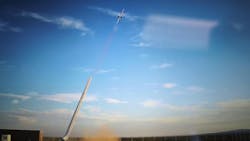Venus Aerospace conducts first U.S. flight test of rotating detonation rocket engine
HOUSTON - Venus Aerospace in Houston announced it has completed what it says is the first U.S. flight test of a rotating detonation rocket engine (RDRE), a propulsion system long theorized but never previously flown in an American-developed vehicle. The test, conducted at Spaceport America in New Mexico, marks a step toward high-speed reusable aircraft capable of traveling more than six times the speed of sound.
RDREs, which use spinning detonation waves for propulsion, have been studied since the 1980s but have proven difficult to implement in operational systems. Venus Aerospace’s successful test demonstrated the engine's performance and integrity under real flight conditions.
"This is the moment we’ve been working toward for five years," said Venus Aerospace CEO and co-founder Sassie Duggleby. "We’ve proven that this technology works—not just in simulations or the lab, but in the air."
Venus Aerospace debuts hypersonic detonation ramjet engine
According to the company, the RDRE offers greater efficiency and compactness than traditional rocket engines, making it well-suited for both defense and commercial applications. The system is designed to integrate with Venus’s VDR2 air-breathing ramjet engine, allowing aircraft to take off from a runway and accelerate to hypersonic speeds without rocket boosters.
"Rotating detonation rocket engines have been a scientific curiosity for decades," said Dr. Rodney Bowersox, aerospace engineering professor at Texas A&M University. "Venus is showing the world that they aren’t just academically interesting - they’re buildable, testable, and operational under real-world conditions."
Andrew Duggleby, Venus’s co-founder and CTO, said the team has solved key engineering challenges to unlock the theoretical benefits of detonation-based propulsion. "We’ve built an engine that not only runs, but runs reliably and efficiently," he said. "This is the foundation we need to complete the system from takeoff to sustained hypersonic flight."
Venus Aerospace just released its Mach 9 spaceplane concept
Hypersonic future
Spaceport America Executive Director Scott McLaughlin called the flight a "milestone moment for hypersonics," adding, "Getting a rotating detonation rocket engine to the launch pad is an achievement few thought possible in such a short time."
Venus is developing a Mach 4 passenger aircraft called Stargazer M4, with plans for full-scale propulsion testing and eventual integration of the RDRE-VDR2 system.
The global hypersonics market is projected to exceed $12 billion by 2030, driven by military and commercial demand. Venus’s successful flight test positions the Houston-based company as a key player in the emerging sector.
Thomas d’Halluin, managing partner at Airbus Ventures, added, "Venus has shown an extraordinary ability to translate deep technical insight into hardware progress. We’re proud to support their bold approach."
About the Author
Jamie Whitney
Senior Editor
Jamie Whitney joined the staff of Military & Aerospace Electronics in 2018 and oversees editorial content and produces news and features for Military & Aerospace Electronics, attends industry events, produces Webcasts, and oversees print production of Military & Aerospace Electronics.
